Sedunnic Armed Forces (Pacifica): Difference between revisions
>Qwert No edit summary |
>Qwert No edit summary |
||
| Line 185: | Line 185: | ||
| ''Plannsevvd'' || [[File:Plannsevvd.jpg|150px]] || General purpose destroyer || ''Plannsevvd'' (Y154)<br>''Nylittverd'' (Y155)<br>''[[Tapparad (Pacifica)|Tapparad]]'' (Y156) || 8,900 tonnes || 2010-2013|| STT || | | ''Plannsevvd'' || [[File:Plannsevvd.jpg|150px]] || General purpose destroyer || ''Plannsevvd'' (Y154)<br>''Nylittverd'' (Y155)<br>''[[Tapparad (Pacifica)|Tapparad]]'' (Y156) || 8,900 tonnes || 2010-2013|| STT || | ||
|- | |- | ||
| ''Vetem'' || [[File:Vetemcl. | | ''Vetem'' || [[File:Vetemcl.png|150px]] || Air-defence destroyer || ''Vetem'' (Y144)<br>''Ullenst'' (Y149) || 7,900 tonnes || (1981)<br>2011-2012|| Levē Kallnhē<br>(STT) || Modified 2011 for air-defence. | ||
|- | |- | ||
| ''Hevv Delltienn'' || [[File:Hevv Delltienn.jpg|150px]]|| General-purpose frigate || ''Hevv Delltienn'' (F541)<br>''Ron Akkallu'' (F542)<br>''Bettu I'' (F543)<br>''Ilva Timienn'' (F544)<br>''Sefi Tygallu'' (F545)<br>''Hejerr Tenteienn'' (F546)<br>''Paksarr Gjerrt'' (F547) || 5,300 tonnes || (1981)<br>2004-2007|| STT || Generally considered a destroyer internationally due to size, armament, and role. | | ''Hevv Delltienn'' || [[File:Hevv Delltienn.jpg|150px]]|| General-purpose frigate || ''Hevv Delltienn'' (F541)<br>''Ron Akkallu'' (F542)<br>''Bettu I'' (F543)<br>''Ilva Timienn'' (F544)<br>''Sefi Tygallu'' (F545)<br>''Hejerr Tenteienn'' (F546)<br>''Paksarr Gjerrt'' (F547) || 5,300 tonnes || (1981)<br>2004-2007|| STT || Generally considered a destroyer internationally due to size, armament, and role. | ||
| Line 287: | Line 287: | ||
== History == | == History == | ||
[[category:Sedunn (Pacifica)]] | |||
Revision as of 23:25, 4 April 2020
| Sedunnic Armed Forces | |
|---|---|
| Rammstovd | |
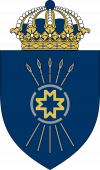 Coat of arms of the Sedunnic Armed Forces | |
| Founded | Antiquity |
| Current form | 2014 |
| Service branches | |
| Headquarters | Essela (peacetime) |
| Leadership | |
| Commander-in-Chief | Sedunnic Government |
| Minister of Defence | Derrns Kappsaty |
| Supreme Commander | General Maks Fejellienn |
| Manpower | |
| Military age | 18 |
| Conscription | 11-month service obligation |
| Active personnel | 71,000 |
| Reserve personnel | 265,500 |
| Deployed personnel | 20,000 |
| Expenditures | |
| Budget | $35.25 billion (2017) |
| Percent of GDP | 4.4% of GDP (2017) |
| Industry | |
| Domestic suppliers | STT Levē Kallnhē Botna SG SLU Sedtrē ASA |
| Foreign suppliers | Karnetvor Resentine |
The Sedunnic Armed Forces (Sedunnic: Rammstovd, literally "the War Authority") is the government agency that forms the military of Sedunn. It has four service branches: Army, Navy, Air Force, and the so-called Teleresources branch.
Military service is mandatory in Sedunn for both men and women, but after several reforms in the 1980s, each year only a minority is conscripted for training after the mandatory entrance assessment tests. Serving abroad is always voluntary in peacetime. The active force is about 71,000 military and civilian voluntary personnel. The reserve force is about 265,500 and has both conscripted and voluntary personnel. The voluntary personnel of the reserve force mainly serves in local defence battalions.
Most of the equipment is manufactured domestically by state-owned companies. Military funding is by tradition high.
Mission and doctrine
The purpose of the Sedunnic Armed Forces is to prevent a foreign occupation of Sedunn and secure its continuing existence as an independent nation by defending the nation, its allies, and its interests in the world, and to assert the territorial integrity of Sedunn and the rule of international law. Furthermore, it shall keep the cross-Pacific trade routes open, support the civil society in case of natural disasters, and support international peacekeeping efforts.
The Sedunnic Armed Forces pursues a doctrine of high mobility, modularity, and often sophisticated equipment. The goal is to gain and maintain overwhelming local fire superiority by the means of combining arms. The ability is seen as a key component to achieve war deterrence. Especially the Navy is also used in access/area denial missions.
Following Tasternine's declaration of independence from the then nationalist Karnetvor in 2009 and King Vimmru II's new foreign policy where military neutrality was abolished, work has begun to increase expeditionary capabilities after decades of planning towards home defence. Sedunn has issued a guarantee of independence to Transsuneria and has generally reassumed a more active role internationally and militarily.
Current international deployments
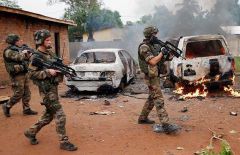
The Sedunnic Armed Forces has deployed expeditionary forces in Reizen of an estimated size of 18,000 troops as part of a agreement between Sedunn, the Frost Empire, the WPR and the RDC. Sedunn promised a saturation attack against RIM targets and follow-up land operations in exchange for the parties returning to the Grovne Ceasefire. The operation was proceeded by a deployment of Special CBRN Operations Units in Reizen to prevent or limit the use of chemical weapons by the RIM. By mid-February 2019 an estimated 25% of the RIM's stockpile had been destroyed.
The Sedunnic Armed Forces also has peacekeeping troops deployed in Transsuneria since the end of the Second Transsunerian Civil War. The number of troops has recently been reduced to a battalion-sized permanent contingent which is tasked with aiding the Transsunerians maintain peace and to protect the Sedunnic naval support base in Floodport. According to current planning, a motorised battalion, a detachment of two to four Hotvemm G84 fighters and a small naval logistics support unit shall be deployed by the end of 2020 the earliest.
The Sedunnic Navy conducts patrol missions on the cross-Pacific trade routes. Sedunn has small naval logistics support units in the allied nations Karnetvor and Resentine.
Recruitment

Military (or civilian) service is compulsory from the age of 18 for all men and women (women since 2017). When turning 17, all Sedunnic citizens take entrance assessment tests (that may be postponed up to the age of 20 under special circumstances). Based on the results, different service alternatives are offered, of which one has choose one. The training is normally at minimum seven months. While many still are conscripted, the yearly number of conscripts has been greatly reduced since the 1980s, more due to modernisation requiring less personnel than an actual disarmament.
After having completed the training, the recruits are given a choice to continue serving in a professional career in one of the standing units, or join the reserve (the so-called mobilisation forces). Personnel that belongs to the reserve are required to participate in recurring refresher training and exercises. After having reached the upper military age, which varies depending on type of service, career personnel and reservists may volunteer to join the local defence forces. There are three different personnel categories: active, conscripted and volunteer, where the latter two belong to the reserve. Personnel in the volunteer category exclusively serve in local defence battalions.
In total, about 2.1% of the population is directly engaged in Sedunn's military defence (about 336,500 personnel), of which 32% serve voluntary units. About 12% are female.
Organisation
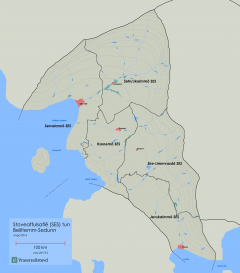
The highest ranking officer in the Sedunnic Armed Forces is the Supreme Commander, currently General Maks Fejellienn. The Supreme Commander is appointed by the Sedunnic Defence Ministry and leads the Armed Forces according to the policy set forth by the Government.
The Supreme Commander leads the Headquarters of the Armed forces, which consists of two staffs: the Operations Command, which plans, directs and controls the usage of the forces, and the Training Command which controls recruitment and training of the personnel in the forces. There are four service branches in the Sedunnic Armed Forces: the Army, the Navy, the Air Force, and the Teleresources. Each service branch has their own operations commands and regional training commands. The Special Forces, the Military Intelligence Service, the Military Materiel Agency and War Research Agency also belong to the Armed Forces and answer directly to the Headquarters.
Defence of the Sedunnic territory is coordinated with the six authority coordination regions where military and civilian efforts are combined under the concept of total defence.
Army
The Army (Trammtasstled, "the Field Forces") is responsible for land operations and is the largest service branch of the Sedunnic Armed Forces, having about 278,000 personnel. The Army fields 12 brigades, six regiments and circa 94 additional battalions of different types. The active force in the Army is about 31,000 personnel, also including training and civilian personnel. Fully mobilised, the Army has the following combat structure.

The main units are:
- Field brigade (x6): the core units of the Army, having a combination of armoured and mechanised manoeuvre battalions. There are two variants: light and heavy. The heavy field brigade has twice as many tanks, double the amount of field artillery and more mechanised infantry, while the light field brigade is more mobile. Main systems include VN 14, VN 86E, AGvN 14, MHRN 14.
- Artillery regiment (x3): providing division-level fire support. The artillery is fully self-propelled and fields both guns and rocket pieces. The 3rd Artillery Regiment has strategic ballistic missiles with long range.
- Mountain brigade (x2): fights in mountainous regions. Mechanisation and access to fire support is much lower than in the field brigades. The main purpose is to deny an opponent access and passage through passes and valleys and surface surveillance.
- City brigade (x2): mechanised infantry brigades uniquely specialised in urban warfare. They also perform honour guard duties. The brigades use lighter armoured vehicles such as from the RN 90 family.
- Airmobile brigade (x1): uses helicopters to perform air assault with light and mobile infantry battalions.
- Airborne brigade (x1): has highly mobile parachute battalions.
- Local defence battalion (x80): are motorised and mechanised rapid response units that guard and protect specific areas and buildings, and assist in the mobilisation of the rest of the army. They mainly inherit personnel and equipment from active and conscripted units.
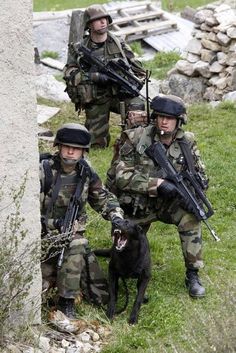
The following units are active in peacetime:
- 2nd Field Brigade:
- 201st Staff Company
- 202nd Reconnaissance Company
- 21st Armoured Battalion
- 23rd Mechanised Infantry Battalion
- 13th Artillery Battalion
- 32nd Brigade Air Defence Battalion
- 21st Support Battalion
- 21st Armoured Engineer Battalion
- 102nd Mountain Reconnaissance Company
- 302nd Mountain Reconnaissance Company
- 31st Mountain Infantry Battalion
- 1st Signal and Command Regiment
- 3rd Artillery Regiment
- 1st Medical Regiment (including Local Defence Corps CBRN units)
- 13th Guard Infantry Battalion
- 223rd Mechanised Infantry Company
- 1st Airmobile Brigade:
- 101st Staff Company
- 11th Airmobile Infantry Battalion
- 12th Airmobile Infantry Battalion
- 141st Logistic Company
- 151st Airmobile Engineer Company
- 1st Airborne Brigade:
- 201st Staff Company
- 111st Airborne Reconnaissance Company
- 12th Airborne Battalion
- 13th Airborne Battalion
- 9th Flodporrt Security Battalion
- 312nd Polar Company
An undisclosed number of security battalion are also active in peacetime.
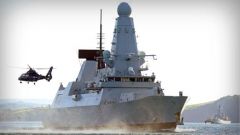
The Navy (Sevvtasstled, "the Sea Forces") is composed of five components: the Surface Forces, the Submarine Forces, the Marine Corps, Auxiliary Forces and Naval Air Service. It includes in total about 22,000 active and 13,500 reserve personnel, 56 combatant ships of various size, additional auxiliary ships, 40 aircraft and 2,000 marines. The Navy is classified as blue-water with some degree of amphibious and replenishment capabilities beyond its own home region. There are no fixed operational formations of combatant ships, instead temporary naval battlegroups are formed for specific missions. The Sedunnic Coast Guard is not part of the Armed Forces and is a civilian component of the Sedunnic Police.
In Sedunnic, vessels are given the prefix "SSR", short for Sedunnō Sevvtasstleō Riks ("Sedunn's Navy's Ship"). In Austral, the prefix "SNS" ("Sedunnic Navy Ship") is used instead.
Active ships
There are approximately 71 ships in commission including 5 destroyers, 7 frigates, 12 corvettes, 12 submarines, 3 amphibious transport docks, 9 patrol boats, 8 mine countermeasures vessels and 15 miscellaneous auxiliary vessels. The total displacement of the Sedunnic Navy is approximately 215,000 tonnes.
| Class | Picture | Type | Ships | Displacement | Commissioned | Builder | Note |
|---|---|---|---|---|---|---|---|
| Submarines (12 in service) | |||||||
| Lusuvvd |  |
Attack submarine | Noslenravad (R159) Levenst (R160) Lunibnes (R161) Sraved (R162) Issd (R163) Ynnivv (R164) Poljiērred (R165) Vastraenn (R166) Sovesienn (R167) |
1,700 tonnes | 1995-2000 | Levē Kallnhē | Diesel-electric. |
| Ressem | Attack submarine | Ressem (R162) Jam (R163) Frot (R164) |
2,400 tonnes | 2015-2019 | Levē Kallnhē | Type of propulsion not revealed. | |
| Amphibious warfare (3 in service) | |||||||
| Noslenravad | 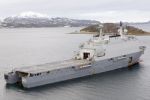 |
Amphibious transport dock | Lusuvvd (T101) | 13,500 tonnes | 1995 | STT | Retirement in 2019 cancelled. |
| Aemmd |  |
Amphibious transport dock | Aemmd (T262) Nuksted (T263) |
11,583 tonnes | 2019 | STT | |
| Surface combatants (24 in service) | |||||||
| Plannsevvd | 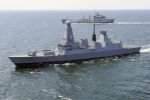 |
General purpose destroyer | Plannsevvd (Y154) Nylittverd (Y155) Tapparad (Y156) |
8,900 tonnes | 2010-2013 | STT | |
| Vetem | 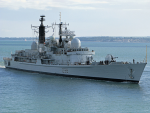 |
Air-defence destroyer | Vetem (Y144) Ullenst (Y149) |
7,900 tonnes | (1981) 2011-2012 |
Levē Kallnhē (STT) |
Modified 2011 for air-defence. |
| Hevv Delltienn | 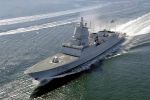 |
General-purpose frigate | Hevv Delltienn (F541) Ron Akkallu (F542) Bettu I (F543) Ilva Timienn (F544) Sefi Tygallu (F545) Hejerr Tenteienn (F546) Paksarr Gjerrt (F547) |
5,300 tonnes | (1981) 2004-2007 |
STT | Generally considered a destroyer internationally due to size, armament, and role. |
| Flered |  |
General-purpose corvette | Flered (K223) Loennvem (K224) Maksob (K225) Fomma (K226) Aeffer (K227) Levivv (K228) |
680 tonnes | 2008-2012 | STT | |
| Jorles |  |
General-purpose corvette | Jorles (K180) Jorin (K181) Samd (K182) Viksad (K183) Insid (K184) Kvold (K185) |
625 tonnes | 1988-1992 | Levē Kallnhē | |
| Patrols (9 in service) | |||||||
| Kapenst | 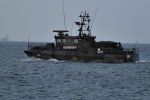 |
Patrol boat | Kapenst (O217) Kravenst (O218) Amvem (O219) Hunnek (O220) Hilphunn (O221) Essjeta (O222) Fedu (O223) Badenst (O224) Myttenst (O225) |
62 tonnes | 1992-1995 | Levē Kallnhē | |
| Mine countermeasures (8 in service) | |||||||
| Sifgvid |  |
Mine countermeasures vessel | Sifgvi (A354) Nuvnet (A355) Delm (A356) Fam (A357) Pass (A358) Mejet (A359) Soret (A360) Attet (A361) |
650 tonnes | 2016-2018 | Levē Kallnhē | |
There are three major naval bases in use, all in Mainland Sedunn, and several smaller in the Mainland as well as in Vastraenn and Transsuneria.
- Essela Base: Sometimes called the military capital of Sedunn, it is home to several Armed Forces commands, army, air force and naval units. Destroyers, submarines and much of the transport vessels are based there, as well as the Marine Corps and larger auxiliary vessels. It is located 15 km north-west of the capital of Sedunn, Grovne.
- Ullenst Base: It maintains the Navy's frigates and some of the corvettes. Sedunn's largest shipyard is located in Ullenst.
- Flered Base: It supports all operations in the Mediterranean Sea. Currently the most important surface combatants stationed there are corvettes. Flered is the second largest port city in Sedunn after Grovne.
Air Force
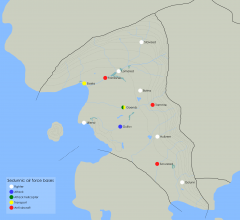
The Air Force (Lytretasstled, "the Air Forces") is the aerial warfare branch of the Sedunnic Armed Forces. It has a strength of about 18,000 active and 5,000 reserve personnel. It includes 168 ASA VOT 14 Hotvemm A/D multirole fighter aircraft in 7 squadrons, three long-range air defence battalions, one attack helicopter squadron and transport aircraft.
The Air Force has 13 main bases. After mobilisation many of the squadrons disperse to temporary bases as a measure against nuclear weapons and preemptive airstrikes. The reserve belonging to the Air Force mainly form base protection battalions and other support personnel.
Current aircraft inventory
| Aircraft | Origin | Type | Variant | In service | Notes |
|---|---|---|---|---|---|
| Combat aircraft | |||||
| ASA VOT 14 Hotvemm | Sedunn | multirole | VOT 14 A | 144 | |
| ASA VOT 14 Hotvemm | Sedunn | strike/multirole | VOT 14 D | 24 | derived from the ASA VOT 14 B Hotvemm |
| AWACS | |||||
| Levea DL-331 | Sedunn | AEW&C | 4 | Designated as TU 8 D | |
| Reconnaissance | |||||
| Levea DL-331 | Sedunn | SIGINT | DL-331 R | 3 | |
| Tanker | |||||
| Levea RL-84 | Sedunn | aerial refuelling/transport | RL-84 M | 2 | |
| Transport | |||||
| Levea DD-211 | Sedunn | VIP | DD-211 J | 2 | |
| Levea RL-84 | Sedunn | tactical airlift | 13 | ||
| MUMS M500 | multi-national | transport | 18 | ||
| Helicopter | |||||
| LIT Industries MAN12 | multi-national | heavy lift | C12 | 25 | |
| Nord X41 | multi-national | utility/transport | 8 | 1 lost in Transsuneria 2016 | |
| Nord X15 | multi-national | light utility | L45C | 9 | |
| KH-88 Gorod | Karnetvor | attack | 1N | 28 | |
| Trainer | |||||
| ASA VOT 14 Hotvemm | Sedunn | conversion trainer | VOT 14 B | 29 | |
| ASA O 31 | Sedunn | jet trainer | 48 | can be used as light strike fighter | |